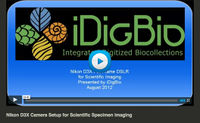Specimen Image Capture: Difference between revisions
Jump to navigation
Jump to search
(→Videos) |
(→Videos) |
||
| Line 52: | Line 52: | ||
|rowspan="1" colspan="2" style="vertical-align:top"| | |rowspan="1" colspan="2" style="vertical-align:top"| | ||
|- | |- | ||
|style="vertical-align:top;"|[[File: | |style="vertical-align:top;"|[[File:BatchProcessingNikon.jpg|thumb|200px|link=https://vimeo.com/46950737|"Batch Processing with Nikon Capture NX2" 04:40]] | ||
|rowspan="1" colspan="2" style="vertical-align:top"| | |rowspan="1" colspan="2" style="vertical-align:top"| | ||
|} | |} | ||
Revision as of 13:02, 25 May 2016
According to Nelson et al. 2012 imaging requires significant specimen handling with attendant opportunities for damage. The process for imaging varies by institution and collection type. The links on this page thereby provide information on Specimen image capture.
Image File Types and File Specifications
- iDigBio's Image File Format Policy and Recommendations
- Introducing the Digital Negative Specification
- Digital Negative Specification for Manufacturers
- [http://www.atiz.com/resources/DPI-PPI-Megapixels-and-Resolution.pdf Atiz Innovation, Inc.: Making sense of DPI, PPI, Megapixels and Resolution
Imaging Documents and Resources
- iDigBio Imaging Equipment Recommendations (Joanna McCaffrey)
- Workflows, protocols, etc. from Tri-Trophic TCN (NYBG and AMNH docs)
- Beginner's Guide to Digital Imaging - Glossary
- Mike Bevans' Digital Imaging and Archiving
- Mike Bevans' So, you want to digitize plant specimens
- Lichen/Bryophyte TCN Imaging Recommendations
- Pacific Northwest Herbaria imaging resources
- The AIC Guide to Digital Photography and Conservation Documentation
- Northern Arizona University's Imaging videos and ppt's
- Imaging References
Imaging Station Equipment and Specifications
- Photo EBox Imaging Station
- iDigBio Imaging Equipment Recommendations
- Assembling Custom Components for Specimen Imaging (NW Herbaria Consortium)
- Sam Noble Musuem's optimization of the efficiency of stackshot, including 3D printing plans for SNO's Focus Stacking Stand, contributed by Roger Burkhalter
- Plans for Sam Noble Museum's Focus Stacking Stand plans and downloads, Roger Burkhalter
- Plans for Sam Noble Museum's Focus Stacking Platform plans and downloads, Roger Burkhalter
- Macroscopic Solutions portable, photo stacking device, overcomes lighting hurdles with copy stands: Macropod
3D Imaging and 3D Printing Resources
- Strata Design 3D CX & Foto 3D CX 7.0.7
- Strata Foto 3D CX
- Image-based 3D modeling: Agisoft PhotoScan
- ZooKeys 328 (2013) : 47-57 Rotational Scanning Electron Micrographs (rSEM): A novel and accessible tool to visualize and communicate complex morphology David Koon-Bong Cheung, Adam Brunke, Nesrine Akkari, Carina Mara Souza, Thomas Pape
- ZooKeys 328 (2013) : 5-45 Revolving SEM images visualising 3D taxonomic characters: application to six species of the millipede genus Ommatoiulus Latzel, 1884, with description of seven new species and an interactive key to the Tunisian members of the genus (Diplopoda, Julida, Julidae) Nesrine Akkari, David Koon-Bong Cheung, Henrik Enghoff, Pavel Stoev
Camera Manuals & Specifications
Videos
| Click for Collapsible List of Videos | ||
| This video provides an introduction to Nikon's camera control software. Camera Control Pro allows users to remotely operate a camera just as if it were in your hand. | ||
| This video provides an introduction to Nikon's camera control software's Live View feature. | ||



